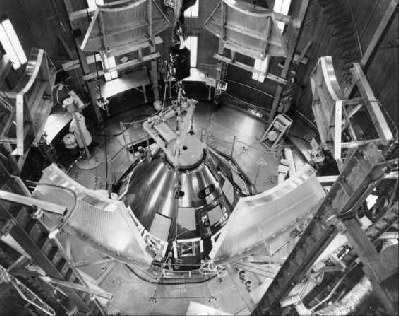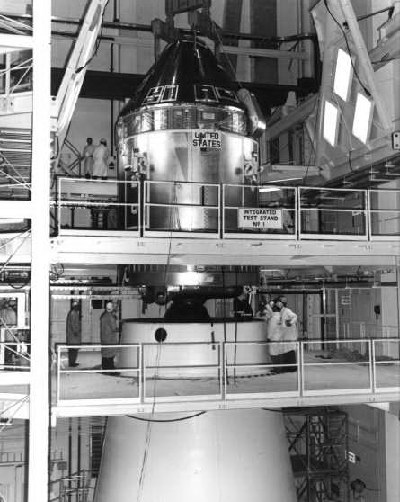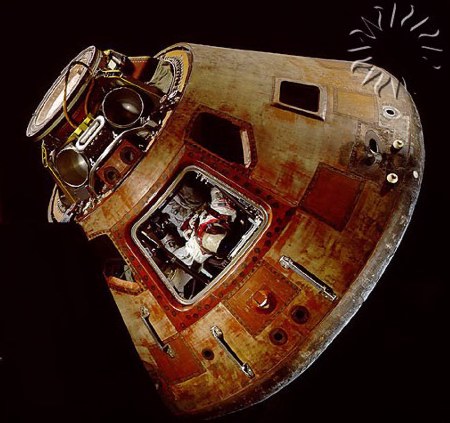www.moonlandings.co.uk
Apollo 11 Page 2
The Apollo 11 spacecraft had three parts: the Command Module, the Service Module, and the Lunar Module (LM) 'Eagle'. While astronauts Armstrong and Aldrin descended to the Moon in 'Eagle', Michael Collins remained alone in 'Columbia'. For 28 hours he served as a communications link and photographed the lunar surface. After reclaiming Armstrong and Aldrin from the ascent stage of the Lunar Module, 'Columbia' was the only part of the spacecraft to return to Earth
 Earth as seen from Apollo 11
Earth as seen from Apollo 11The blunt-end design for the Command Module was chosen to build upon experience gained with the similarly shaped Mercury and Gemini spacecraft. The spacecraft reentered the atmosphere with its protective heat shield facing forward. Layers of special 'ablative' material on the shield were purposely allowed to burn away during reentry to help dissipate the extremely high temperatures caused by atmospheric friction.
Command Module Statistics:
Height: 3.2 m
Maximum Diameter: 3.9 m
Weight: 5900 kg
Manufacturer: North American Rockwell for NASA
Launch Vehicle: Saturn V

Above: Testing the Apollo 11 spacecraft in the operations and checkout building. The command and service modules in an altitude chamber. Segments of a workstand, used to work near the top of the spacecraft, have been lifted and pulled back against the circular walls of the chamber

Above: Mating the command and service modules with the spacecraft-lunar module adapter

An artist's impression of the Command Module during re-entry
Following their historic landing and exploration of the lunar surface, Neil Armstrong and Buzz Aldrin rejoined Michael Collins aboard the Command Module. Collins, as Command Module Pilot, fired the Service Module’s large engine and headed back to Earth. Several days later on 24 July, they discarded the Service Module and entered Earth's atmosphere. To protect the crew and the priceless cargo, Columbia's exterior was covered with a phenolic epoxy resin ablative heatshield. As it entered the atmosphere at a speed of 40,000 km/h, its exterior reached a temperature of 2760º C burning off most of the reflecting film cover. The heatshield protected the craft from burning and vaporising. Columbia finished its flight with a parachute landing in the Pacific Ocean. The remainder of the kapton film was removed after the flight.
The cone-shaped command module is divided into three compartments: forward, crew and aft. The forward compartment is at the cone's apex, the crew compartment is in the centre, and the aft compartment is in the base (the blunt end) of the craft. The forward compartment contained the parachutes and recovery equipment. The aft compartment is divided into 24 bays by the structural supports. It contains 10 reaction control engines, fuel, oxidizer and helium tanks for the roll, pitch and yaw thrusters, and the crushable ribs of the impact attenuation system. The crew compartment has a volume of 5.9 cubic metres. It contains three couches for the crew during launch and landing. The couches are arranged so that each astronaut faces the main instrument panel. During flight, the astronauts could fold-up the couches to make more room in the spacecraft. Near the feet of the couches, in the lower equipment bay, there is enough room to stand up
Columbia had a single astronaut in the centre seat. The Command Module has two hatches: the side hatch and the forward hatch, which was used to transfer to the lunar module. It has five windows (two side, two rendezvous windows, and a window in the hatch). The outer windows soften at 1554ºC and melt at 1705ºC. On the side of the spacecraft below and above the hatch are the upper and lower sets of pitch thrusters (further details)